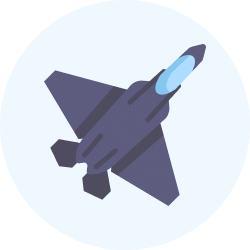Methods of Charging: Friction, Conduction & Induction | Physics for Airmen Group X - Airforce X Y / Indian Navy SSR PDF Download
METHODS OF CHARGING
(i) Charging by friction: Charging by friction is the oldest form of charging. It was found that when an amber rod is rubbed with fur, the rod became negatively charged. The two bodies acquire opposite signs of electricity; one gets positively charged, while the other becomes negatively charged.

Fig. Charging by friction
When two bodies are charged by friction, they acquire the same magnitude of charge. Furthermore, the bodies retain these excess charges even when they are separated from each other.
Note: Charging involves transformation of mass.
(ii) Charging by conduction: In charging by contact, an uncharged body is brought into contact with a charged body. The uncharged body acquires the same sign of charge as the charged body. The total charge is distributed between the two bodies.

Fig. Charging by conduction
(iii) Charging by Induction
Charging by induction occurs when we bring a charged object near a conductor. It is not for no reasons that we say near. The charged object does not physically touch the conductor. The charged object is just allowed to get close to the conductor.
As a result, the conductor will be charged. We say that a charge has been induced in the conductor. We will make this clear with an experiment.
Experiment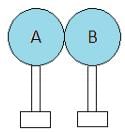 Step 1: Consider the two spheres above made with a metal. Since metal is a good conductor, it is a good choice for this experiment.
Step 1: Consider the two spheres above made with a metal. Since metal is a good conductor, it is a good choice for this experiment.
- They touch each other, so they become a single conductor.
- We put them on insulated stands so charges or electricity does not travel to the ground.
- The two spheres right now form a neutral system. This means that there is the same amount of electrons and protons in each sphere.
Step 2: We get a rod that is negatively charged and we put it next to the two spheres. The rod is shown on the right in green. The lines inside the rod represent negative charges. 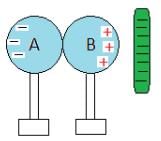 Electrons in sphere B are repelled by the rod and move to sphere A to create an excessive charge called also net charge. This situation creates also a net charge in sphere B.
Electrons in sphere B are repelled by the rod and move to sphere A to create an excessive charge called also net charge. This situation creates also a net charge in sphere B.
We say that a charge has been induced on the spheres.
Step 3: We can separate the spheres while the rod is still there.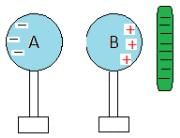 Step 4: Finally, we can remove the rod completely.
Step 4: Finally, we can remove the rod completely.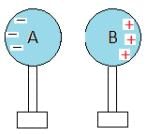 The spheres will keep their charges and this is what we mean by charging by induction. The charges on the spheres are equal and opposite.
The spheres will keep their charges and this is what we mean by charging by induction. The charges on the spheres are equal and opposite.
Note: That the charges are equal because for each single electron that goes to A and therefore creates a single negative net charge, it leaves B with a single positive charge.
In our example above, let’s assume 3 electrons went to A creating a situation where B has a positive charge with 3 protons. Keep in mind that spheres A and B could have billions and billions of electrons. The reason that sphere A is charged now is because it has an excess of 3 electrons although this is a small charge. By the same token, the reason sphere B is charged is because it has 3 more protons now than electrons.
Charging by induction and grounding
Use only 1 sphere this time and induce a charge again with a charged rod. Then, put your finger on the side where negative charge is induced i.e. away from the rod.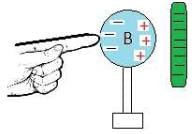 When you touch the metal with your finger, electrons leave the sphere by means of your finger and enter the ground through your body.
When you touch the metal with your finger, electrons leave the sphere by means of your finger and enter the ground through your body.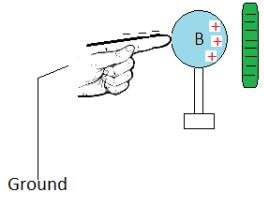 When we allow charges or electricity to leave a conductor by touching it, we call it grounding the conductor.
When we allow charges or electricity to leave a conductor by touching it, we call it grounding the conductor.
Note: That neutral body does not imply a ‘charge-less’ body. It means a microscopic balance of –ve and +ve charge in the body.
|
201 videos|410 docs|280 tests
|
FAQs on Methods of Charging: Friction, Conduction & Induction - Physics for Airmen Group X - Airforce X Y / Indian Navy SSR
| 1. What is friction charging and how does it work? |  |
| 2. How does conduction charging occur? |  |
| 3. What is induction charging and how is it different from conduction charging? |  |
| 4. Can all materials be charged through friction, conduction, and induction? |  |
| 5. What are some real-life applications of charging by friction, conduction, and induction? |  |



